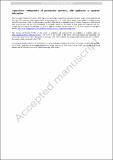Approximate orthogonality of permutation operators, with application to quantum information
Author(s)
Harrow, Aram W.
Download11005_2023_1744_ReferencePDF.pdf (658.6Kb)
Open Access Policy
Open Access Policy
Creative Commons Attribution-Noncommercial-Share Alike
Terms of use
Metadata
Show full item recordAbstract
Consider the n! different unitary matrices that permute n d-dimensional quantum systems. If
$$d\ge n$$
d
≥
n
then they are linearly independent. This paper discusses a sense in which they are approximately orthogonal (with respect to the Hilbert–Schmidt inner product,
$$\langle A,B\rangle = \textrm{tr}A^\dag B/\textrm{tr}I$$
⟨
A
,
B
⟩
=
tr
A
†
B
/
tr
I
) if
$$d\gg n^2$$
d
≫
n
2
, or, in a different sense, if
$$d\gg n$$
d
≫
n
. Previous work had shown pairwise approximate orthogonality of these matrices, but here we show a more collective statement, quantified in terms of the operator norm distance of the Gram matrix to the identity matrix. This simple point has several applications in quantum information and random matrix theory: (1) showing that random maximally entangled states resemble fully random states, (2) showing that Boson sampling output probabilities resemble those from Gaussian matrices, (3) improving the Eggeling–Werner scheme for multipartite data hiding, (4) proving that the product test of Harrow–Montanaro cannot be performed using LOCC without a large number of copies of the state to be tested, (5) proving that the purity of a quantum state also cannot be efficiently tested using LOCC, and (6, published separately with Brandão and Horodecki) helping prove that poly-size random quantum circuits are poly-designs.
Date issued
2023-12-16Department
Massachusetts Institute of Technology. Center for Theoretical PhysicsPublisher
Springer Netherlands
Citation
Letters in Mathematical Physics. 2023 Dec 16;114(1):1
Version: Author's final manuscript